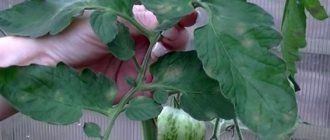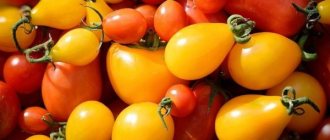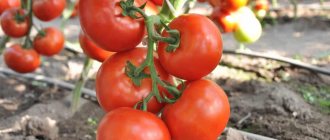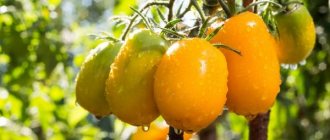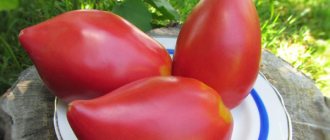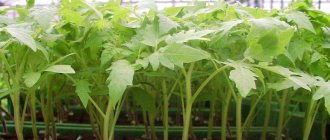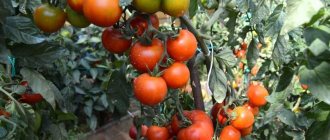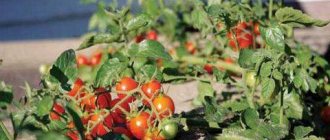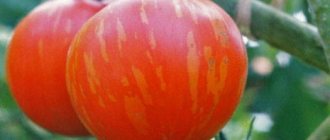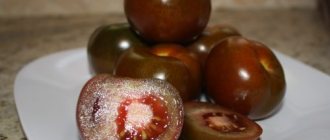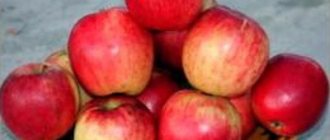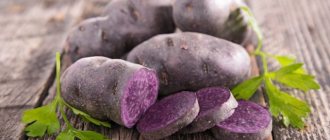The “homeland” of Minusinsk tomatoes is the city of Minusinsk, Krasnoyarsk Territory, where they were bred by one of the leading gardeners. “Minusinsk Tomato Day” is even celebrated here. This group of varieties is famous not only for its resistance to cold, impressive size, but also for the incredible taste of the fruit.
Minusinsk tomatoes are consistently popular among gardeners. Many note their high yield, as well as the ability to grow both in open ground and in greenhouses.
In the article we will talk in detail about the features of Minusinsk tomatoes, varieties, and also give advice on growing and care.
Characteristics and description of the variety
Minusinsk tomatoes are classified as mid-season indeterminate (tall) varieties. The bush can reach up to 2.5 meters in height and requires garter. Most often, the bush develops one or two stems. The leaves of the plant are medium in size and dark green in color.
Tomato fruits reach up to 1 kg and have a rich crimson color. The photo shows that the tomato has smooth skin and small seed chambers. The pulp of the fruit is juicy, not watery. It is also known that Minusinsk tomatoes are famous for their excellent sweet taste.
Apple variety
Apple tomato is a mid-season, sleepy variety. The bush is tall and requires timely garter. Compared to other varieties, apple is relatively small (up to 500 g). Tomato fruits are red, flat-round in shape. The taste is harmonious, balanced, pleasant. Gardeners who grow the variety report good yields.
Minusinsk glasses
These glass-shaped tomatoes are not suitable for growing in the middle and northern regions, so they are recommended to be planted in greenhouses. They are distinguished by pink, bright red or orange-pink color . The length of the stem reaches 2.5 m, and the fruits themselves are distinguished by their small size - up to 300 g.
The fruit has a dense peel, which makes it not susceptible to cracking. Due to the increased sugar content, tomato is most often consumed fresh. However, this variety is also suitable for preservation.
In terms of external and taste characteristics, “Glass” is often confused with the “Minusinsk bulls” variety, however, the latter differs in the shape of the fruit.
Some amazing history
The first variety of Minusinsk tomatoes was discovered at the end of the 19th century by local gardener Starukhin and gained success in Siberia. The fact is that, in principle, growing tomatoes in Siberian conditions is already interesting, and getting a fruit measuring 750 grams and more than 40 cm in diameter was a great achievement at that time. Thus, the first description of the Minusinsk tomato was obtained.
Minusinsk is located in a basin with a unique and stable microclimate. Winter temperatures are on average within -20°C, summer temperatures within +20-25°C, the growing season is up to 160 days. Summer days are mostly clear and dry. This area is called Siberian Italy. Under this climate, varieties of the Minusinsk tomato series were obtained, the main difference of which is their large fruit and pronounced sweet taste.
In the early 2000s, the governor of the Krasnoyarsk Territory ordered an annual August holiday called Tomato Day, held in Minusinsk. The winner of the competition, who grows the largest and most delicious fruit, receives a car every year. The absolute record was the Bull's Heart tomato with a weight of 2146 grams. Moreover, an important point is the fact of using organic fertilizers when growing.
We want to tell you about this series, give characteristics, descriptions and varieties of tomatoes - Minusinsk, tell you about the features of cultivation.
We hope that you will also want to treat your entire family to one tomato of these varieties - large, meaty, and the most delicious.
Excellent photo of a Minusinsk tomato
Advantages and disadvantages
Minusinsk tomatoes have many advantages over other varieties:
- high productivity;
- good taste of fruits and their large size;
- the ability to grow the variety both in greenhouses and in open ground;
- fruit resistance to cracking.
Flaws:
- instability to temperature changes;
- requirement for regular watering and weeding;
- complex agricultural technology of plants (bushes require tying up after planting in a permanent place of growth).
Minusinsk varieties of tomatoes: briefly about real representatives
Minusinsk varieties of tomatoes: briefly about real representatives
In the Krasnoyarsk region there is the city of Minusinsk, where every year they hold a holiday - “Minusinsk tomato”. These are annual folk festivals, and every year they hold a fair in honor of tomatoes. The tomatoes sold at this fair are grown on local plots. There is a competition at the fair. The contestants' task is to grow the largest tomato in a year and present it to the jury members. The main prize in this competition can be a car.
Growing and care
Seeds of Minusinsk tomatoes are not recommended to be sown directly into the ground. They need to be grown by seedlings to achieve good germination.
It is recommended to prepare seedlings 60 days before transplanting plants to a permanent place of growth. To grow seedlings, special deep boxes are used. It is better to take universal ready-made soil. The soil temperature should not be below +22 degrees, otherwise the seedlings may die.
In the open ground
Seeds for seedlings are sown in early or mid-March.
To grow young viable plants you need:
- Properly prepare seeds for planting. To do this, they need to be placed in a cloth moistened with warm, clean water for a day.
- Prepare the soil for seedlings. If you use a ready-made mixture from the store, just bake it in the oven. It is important that its temperature is not lower than +22 degrees at the time of sowing the seed. If you use soil collected from your own local area, pre-treat it with a weak solution of potassium permanganate for the purpose of disinfection.
- Seeds are sown in seedling pots at a distance of 2 cm from each other and buried 1 cm in the ground. After this, the seedlings are watered and covered with film or glass.
- When the first shoots appear in the pots, the film is removed. After this, the seedlings are watered once a week. Also during this period it is necessary to create temperature fluctuations for tomatoes. Move the boxes from one place to another so that the temperature readings change. Do this daily.
- As soon as the plants have 2 true leaves, the seedlings need to be pricked. Viable, strong plants are planted in separate pots. Two weeks after this, the plants are fed with a nitrophoska solution.
- Before transplanting tomatoes to a permanent growing location, the crop must be “hardened off”. To begin with, take the flowerpots with young tomatoes outside for an hour, gradually increasing the time spent in the air.
- As the bush grows, it needs to be pinched. The top must be trimmed so that it produces shoots. The side branches are gradually removed so that they do not take away the vitality of the plant.
After the plant has at least 8 leaves and one true inflorescence, it is transplanted to a permanent place of growth. Small holes up to 12 cm deep are prepared for plants. They are arranged in a checkerboard pattern so that there are no more than 3 plants per 1 square meter. The tomatoes are transplanted into holes together with a lump of earth, dug in, leaving a small depression around the plant, and watered again.
After planting the plants in the ground, they will need care:
- plucking a bush;
- mulching the soil;
- watering at least once a week;
- fertilizing with mineral fertilizers 2 times during the flowering period and 2 times during the growing season.
In greenhouses
In greenhouse conditions, tomato bushes with 2 stems are formed. After they reach a height of 1.45 m, the plants are pinched to stop growth. Mandatory elements of caring for bushes here remain regular watering of tomatoes in the greenhouse, fertilizing, and tying to a trellis . Watering both in greenhouse conditions and in open ground is done strictly at the root. If water gets on the leaves, it may cause burns.
Also, Minusinsk tomatoes grown in a greenhouse need to be provided with the correct level of humidity. It should not exceed 70%, especially during the flowering period of plants. For this purpose, be sure to ventilate the greenhouse, especially after watering.
general information
In the city of Minusinsk, Krasnoyarsk Territory, Russia, the regional festival “Minusinsk Tomato” is held annually. The folk festival smoothly turns into a fair with a brisk trade in tomatoes grown in the fields and gardens of local residents.
There is also a competition at the festival, often the prize is a car. The essence of the competition is that the winner is the one who presents to the jury the largest tomato allegedly grown on the lands of Minusinsk.
For example, in 2021 the winner was the Sprint Timer tomato variety, and its weight was 1878 grams. In 2014, “Pink Honey” won, weighing 1506 g, but it has not yet been possible to surpass the 2011 record (2146 g).
Looking at this information, it becomes clear that what is served on the seed market under the “Minusinsk Tomatoes” series is nothing more than material promoted by someone.
Giant Minusinsky
The Minusinsk giant is capable of producing vegetables weighing up to 1.5 kg, and can give a scattering of relatively small 300-gram tomatoes - it all depends on the growing conditions and personal preferences of the gardener.
Since the stem of the plant is very high - from 2 m and above, tying and pinching are required, but for better results it is also recommended to carry out topping.
To obtain heavy, giant fruits, a long bush is formed into one main stem, all stepsons are removed immediately after appearance, and the number of fruits on the bush is regulated by the required amount. For standard yields with tomatoes weighing up to 700 g, you can leave the lower stepson to form a second stem. It is allowed to plant from 2 to 3 seedlings per 1 m2.
Giant tomatoes have a bright red color and are shaped like hearts, and the smaller the size, the more pronounced the “heart”. The taste of the fruit is very sweet, sugary.
Description of the series
It should be noted that the register of breeding achievements of the Russian Federation did not record “Minusinsk” tomatoes.
The series itself is presented as tall and large-fruited tomatoes. However, by some miracle, others (all sorts and different) joined them. Let's take a closer look.
"Minusinsk Harvest"
Tomato "Minusinsk Harvest" description and photo will not tell you anything. What kind of variety it is and who is presenting it is not clear.
Reviews from collectors indicate a large mismatch. If you purchase 5 seeds, they will often all be different.
"Bull's Heart Minusinsk"
If the original variety “Bull's Heart” (agricultural firm Poisk) is determinate, then the tomato “Bull's Heart Minusinsk” is presented as an indeterminate variety.
Characteristics and description
When describing the plant form, they talk about tall growth and the need to grow in one shoot.
Tomatoes are medium ripening, heart-shaped, pink with slight ribbing. The weight of the fruit is within 300-400 g, some up to 500 g.
Those who grew them claim that the plant produces large tomatoes, but only 1-2 on the lower shoots, the rest are much smaller and not all maintain the heart-shaped form.
The tomatoes are fleshy, low in seeds and have a pleasant, balanced taste.
- Large fruit;
- Good taste;
- Resistance to weather changes.
- low yield (the bush produces 5-7 fruits);
- demands on formation.
"Minusinsk Apple"
Minusinsk apple tomato, mid-season variety. The indeterminate bush requires formation and timely garter.
The fruits are red, weighty (up to 500 g), flat-round in shape. The fracture clearly shows the sugar content and a small number of seeds. The taste is harmonious, balanced, pleasant.
Those who grew them talk about good yields, but the Minusinsk apple tomato is no different from the wild variety.
- High yield;
- Disease resistance
"Minusinsk balls"
Tomatoes of this variety look interesting on the bushes. Huge red tomatoes, weighing 300-400 g, some up to 500.
Those who grew the Minusinsk ball tomato speak about the heterogeneity of fruit production. Tomatoes are not aligned in shape and weight.
The taste is good. The tomato is used as a salad and for processing. The tomato is resistant to atmospheric changes and is not susceptible to attack by pathogens.
- resistance to weather and disease;
- good taste;
- large-fruited.
As a disadvantage, poor commercial output.
"Minusinsk giant"
Most likely, this particular fruit is destined to take first place in giant tomato competitions.
It is alarming that the photos of this tomato are very different. Both round and flat-round red tomatoes are presented.
The size limits are described as 500-700 g, but the photo shows that the tomatoes clearly do not reach the indicated numbers.
Those who purchased the original seeds do not really approve of the Minusinsk giant tomato, since the mis-grading did not allow us to understand what a tomato should really be like.
"Bull forehead of Minusinsk"
This tomato is served as indeterminate, flat-round, red and large-fruited. The photo usually shows large, smooth tomatoes with slight ribbing.
Those who planted the “Bull’s forehead Minusinsk” tomato talk about the high yield of tomatoes with an average weight of 250-300 g. The tomatoes are fleshy, elastic, for salad purposes with a beautiful habit.
There are especially many reviews about the taste of this tomato. The high balance of organic acids and sugars makes this variety of folk selection in demand. Tomato products of this variety are not available in excess, as they are in demand in the vegetable market.
- excellent taste;
- large fruit;
- high yield.
- the need for constant formation due to the increased ability to form stepsons;
- constant garters of shoots and fruits to avoid breakages due to large fruits.
"Burlak Minusinsky"
presents seeds called “Burlak F1”, which are also not included in the register of breeding achievements, but the tomato “Burlak Minusinsky” is very similar in description to this hybrid. Therefore, when purchasing seeds, you need to take into account that this may be a hybrid of local selection, and even if a good result is obtained, subsequent “children” may differ significantly from the parent form.
The leaf blade of this potato-type tomato variety is not very large, dark green. Early ripening plant. The fruit is flat-round, ribbed, sometimes strongly ribbed, pink-red in color without a green spot at the base.
The pulp of the fruit is fleshy, “sugar-like”, tender. The taste is good, and in favorable weather conditions even excellent. The optimal amount of sugars and acids makes the fruit very delicious, and the fairly dense skin does not allow the tomatoes to crack.
- large fruit;
- good taste;
- early ripening.
- excessive ribbing;
- bells and whistles on tomato fruits;
- unevenness of fruits (from 60 g to 350 g).
"Soldatovo"
A tall tomato that produces oval-cylindrical fruits. Those who grew it describe the Soldatovo tomato as having a medium ripening period, with good yield and resistance to diseases and pests.
The taste of tomato is high. The fruits are smooth, with smooth thin skin, sweet.
The tomato reaches a height of two meters, and is formed into one or two shoots. The weight of an average fruit is about 300 g, and each cluster carries 4-5 tomatoes, so it must be carefully tied up.
There are 3-4 seed chambers, but they are not hollow, filled with tomato pulp.
- large fruit;
- interesting shape;
- excellent taste;
- uniformity of commercial tomato.
"Pepper-shaped Minusinsky"
Vegetable growers like varieties of unusual shapes, and the Minusinsk pepper tomato has an elongated shape reminiscent of a pepper fruit up to 10 centimeters long. The plant is indeterminate, with medium foliage. The tomato is average in terms of ripening time.
The fruits are red, uneven in weight. Each bunch carries a large tomato up to 200 g, a medium one up to 120 g and a not very small tomato up to 80 g. The fruit is elastic, fleshy, moderately juicy, with a small number of seeds.
Universal tomatoes. They are suitable for salads, as well as processing into tomato products and whole canning. Many vegetable growers point to excellent processed products, as the juice is thick, dense and has a very beautiful, rich color.
- interesting shape;
- good taste;
- versatility of use;
- high productivity;
- early ripening.
“Podsinevsky hearts of Minusinsk”
By planting early tomatoes, you won’t be able to get them, but as mid-early ones you will be pleased with their harvest. The first tomatoes can be obtained weighing up to 600 g. The plant will produce 1-2 such weighty fruits, then the tomatoes will be smaller, their weight ranges from 250 to 300 g.
The Podsinevskoye Heart Minusinsk tomato has a pronounced heart-shaped shape with slight ribbing at the base. When ripe, the tomato bears a green spot, then it dissolves and the fruit acquires a dark, rich, pink color.
The seed chambers cannot be seen in the section. The fruit has a “watermelon”, sugar texture, velvety, rich, dense. Small quantity of seeds.
The taste is very good. The tomatoes are sweet, aromatic with a pleasant aftertaste.
- large fruit;
- excellent yield;
- disease resistance;
- great taste.
"Minusinsk long pink"
Why the long pink Minusinsk tomato is considered separately is unknown, since many vegetable growers equate it with pepper. Some argue that this fruit is more fleshy, however, in order to compare these varieties of folk selection, you need to sow them and grow them in the same conditions.
From the reviews of those who planted it, it follows that the tomato:
- average ripening period;
- tall;
- large-fruited;
- has interesting, oval-elongated fruits;
- meaty with good taste.
Some vegetable growers, sharing their impressions of the variety, say that the pepper-shaped one is more hollow and has an elongated, elongated “tip,” while the long pink one ends its fruit bluntly with a “tip.”
"Minusinsk bulls"
The tomato has a strange name, but familiar to the Minusinsk people, since the “Minusinsk bull” tomato was grown by many. The plant is tall, sometimes reaches the top of the greenhouse and has to be pinched. Each brush bears 5-6 uniform, weighty, oval-cylindrical, sometimes cuboidal tomatoes, with a slightly drawn-out tip, the so-called “spout”.
The fruits are pink, rich in color, dense, fleshy with excellent taste. The lower clusters will produce tomatoes weighing up to 400 g. On the upper ones, the fruits will weigh 250-300 g, but they all ripen at the same time.
Varietal diversity
Minusinsk tomatoes come in several types:
- Minusinsk goby;
- Minusinsk barrel;
- Burlak Minusinsk;
- Minusinsk bull heart;
- Minusinsk glasses;
- Pepper-shaped Minusinsk;
- Minusinsk giant tomato;
- Minusinsk apple tomato.
Tomatoes Minusinsk
Tomato “pepper” of folk selection
The fame of these interesting varieties has been going on for a long time, and although the variety is not included in the State Register, it is a favorite among many gardeners. The tomato is mid-season, indet, and gives good results when grown indoors.
The bush reaches a height of almost two meters, so immediately, when planting plants in a greenhouse, you need to think about what supports will be made. They use stakes with garters, as well as a convenient and practical trellis method.
ON A NOTE! The peculiarity of this variety (like almost all tomatoes of the Minusinsky series) is its fragile branches. It is required to take very careful and careful care of the plants, providing them with support and tying.
The leaves are ordinary, simple, rich green. The tomato variety Pepper-shaped Long Minusinsk is included in the group of raceme-type tomatoes, since its fruits ripen in clusters. Such varieties have certain features, which will be discussed below, and agricultural technology must take them into account.
The fruits are elongated, reach up to 12-15 cm in length, and are shaped very much like sweet pepper pods or cucumbers. There is a small “spout” at the top. The skin is dense, in unripe tomatoes its color is green, in a state of full (biological ripeness) it is rich red.
The weight of the fruit varies; one bunch can contain 80-100 grams of tomatoes, or about 200 grams. Small tomatoes are great for canning; they can be rolled whole into jars. Larger tomatoes are cut into slices and also canned or salted. Under the skin there is fleshy and juicy pulp, there are few seeds. The fruits are often used for purees and juices, and for slicing.
The bush of the Pepper-shaped long Minusinsk variety with ripening clusters of fruits looks very beautiful. During the period of mass fruiting, it is recommended to tie up not only stems and branches, but also individual brushes.
Diseases and pests
Minusinsk tomatoes are resistant to many diseases that affect plants of the nightshade family. Top and root rot are dangerous for them. You can cope with them with the help of phytosporin. To combat diseases, it is recommended to first remove diseased plants and then spray healthy ones.
This tomato variety is also susceptible to late blight. To combat it, you need to treat crops with copper-containing preparations.
Read about how to effectively combat late blight on tomatoes in this article.
Manifestation of late blight.
All plants affected by late blight must be removed from the garden bed and burned. They cannot be treated.
Among the pests, the most dangerous for this crop are long whiteflies, spider mites, mole crickets, and slugs. To get rid of them, plants need to be sprayed with a weak solution of potassium permanganate. Before the flowering period of the bushes, insecticides can be used to control pests.
Lord
The Minusinsk variety Vlastelin ripens in 111-118 days. They are grown in greenhouses. The tomato is recommended for regions with mild summers.
The plant is indeterminate, it is formed, pruned and stepsoned. The leaves are removed below the cluster, at which the berries reach blanzhe ripeness. They are heart-shaped, pink flesh:
| № | Helpful information |
| 1 | weight – 300-500 g |
| 2 | productivity of 1 plant – 5 kg |
| 3 | salad purpose |
| 4 | plants protect against infections and insects. Use biological products |
Minusinsk tomatoes of the Vlastelin variety are grown from seedlings for 60-65 days. Sowing is carried out in mid-March. When real leaves appear, a dive is carried out. The variety is not prone to fattening. Seedlings are fed with a mineral complex once a month.
A good harvest of tomatoes can only be obtained on fertile soil. The bed is enriched with compost. To make the soil loose, add peat or sand.
Ash is used against fungal infections. Watering is organized for the plants and frequent loosening is carried out. Compost and ash are added around the bushes.
The Gigant variety has similar characteristics, but its fruits are slightly larger. The main part of the berries on the bush is collected 400 g. The lower ones are collected 700 g; brushes need to be supported. The plant is indeterminate, for greenhouse cultivation.
More on the topic: What are the characteristics of the Gulliver tomato?
Pepper-shaped
Certain varieties of Minusinsk tomatoes are classified into the group of pepper tomatoes. They are distinguished by their elongated shape. Red in color. Externally, tomatoes resemble bell pepper pods. Their pulp takes up all the space. The seeds are located in 2 nests. There are few of them:
- Pepper-shaped Long – medium early. Tomatoes weighing 350 g ripen on the second cluster. The main part of the bush is occupied by berries weighing 200 g. The last ovaries are small, up to 80 g. Productivity 5 kg/bush;
- Podsinskoye Miracle – 150-300 g. Tomatoes belong to the salad group and are processed. With good care, one plant brings up to 6 kg;
- Soldatovo – plum-shaped, elongated shape. The Soldatovo variety can gain 150-300 g. The pulp is juicy, the shell is dense;
- Pink Glasses - the bush is formed into 1 stem. Up to 9 brushes can be formed on it. Up to 6-8 ovaries can develop on one branch. The largest tomatoes, more than 350 g, are formed on 2 brushes. Productivity 7 kg/bush.
More on the topic: How to care for a tomato Intuition?
All varieties of pepper tomatoes are indeterminate. They are grown in protected soil. 1-2 stems are grown on a bush and planted. Tomatoes are grown from seedlings. It is kept in a greenhouse for 65-70 days.
Igor Nikolaev
auto RU
Varieties of pepper tomatoes are unpretentious. They tolerate high humidity and dry periods. When the soil is waterlogged, the berries do not crack. They are good for pickling.
The ovary on the lower hands matures in 115-120 days. The optimal temperature for successful fruiting is 25 C. In the sun, the berries gain more sweetness.
Balls Minusinsk
Minusinsk balls look like real dwarfs in size of their bright, red-pink fruits - only about 200 g, and the yield of the bush, in comparison with other Minusinsk trees, is considered average - within 3-3.5 kg, and this is with double-stem formation!
The fruits are very dense, with a lot of juice, sweet, but are intolerant to high soil moisture - they immediately begin to crack and quickly lose their presentation.
Harvest Minusinsk
Minusinsky Harvest variety is one of the most fertile, capable of producing 6 kg or more per bush, with a relatively small size of the plant as a whole. Fruits of the standard type - 200-250 g are obtained when a bush is formed into two stems, larger tomatoes - up to 400 g, grow on a single-stemmed bush.
The fruit is not grainy when broken; the core is dense, juicy, moderately sweet, and has a rich red hue. The fruits are used in all kinds of culinary recipes and are especially good in preservation.
For all types of this assortment, the following are required: pinching, pinching, mulching and timely feeding. The scheme for watering seedlings is the same for all large-fruited fruits, but hardening off the seedlings before planting in the ground cannot be avoided - Minusinsk varieties are very susceptible to sudden changes in temperature conditions.
Features of pink tomato from Minusinsk
Despite the fact that the fruits of this variety have a large weight and diameter (they can reach a weight of one and a half kilograms), the bushes of this hybrid are quite thin and brittle. You need to know how to properly tie it to a trellis immediately after transplanting it to a permanent growing location, be it a greenhouse or open ground. Otherwise, their stems may break under the weight of ripening fruits. Also, to obtain a good harvest, the bushes must be pinched, forming only one stem. Otherwise, the gardener may receive a small amount of fruit, and the tomatoes themselves will not be sweet and too small for this variety.
Country of origin and growing regions
The presented hybrid was bred in the 19th century by the gardener Starukhin. He grew it in the Minusinsk Basin in Siberia, which is how the hybrid got its name. The variety turned out to be resistant to Siberian climatic conditions. It quickly became widespread outside the region.
The best varieties of cucumbers for Siberia can be found here.
The tomato fruits bred by Starukhin weighed 745.5 grams and their diameter was 43 centimeters. In those days it was an absolute record.
Nowadays, this variety, like the Klusha, Danko and Kumato varieties, is successfully grown in all regions of Russia. In most areas it can be grown in open ground, only in the northern regions with the most severe climate it is recommended to plant it in greenhouses. To determine the timing of planting tomatoes, gardeners often rely on the lunar calendar, thanks to which they can understand in which month to plant seedlings.
Advantages and disadvantages
Minusinsk tomatoes have many advantages over other varieties. These include:
- high productivity;
- good taste of fruits and their large size;
- the ability to grow this variety both in greenhouses and in open ground;
- fruit resistance to cracking.
You can read about growing tomatoes in a polycarbonate greenhouse here.
It should be noted that the fruits of the Minusinsk tomato contain a large amount of vitamins and useful minerals. They contain vitamins A, B, C, K, as well as iodine, calcium, and potassium. Eating two of these tomatoes a day will cover the body’s daily needs for all useful elements and vitamins.
The disadvantages of this variety include complex plant agricultural technology. Bushes of Minusinsk tomatoes require tying up after planting in a permanent place of growth; they are not resistant to temperature changes, require regular watering, weeding and knowledge of how to plant completely.
Tomato planting scheme
